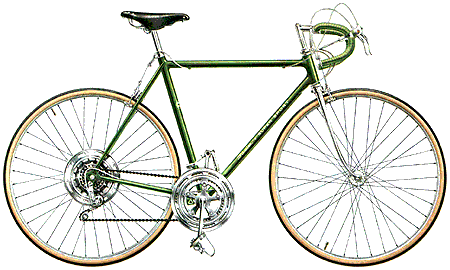Schwinn Bicycles Serial Numbers

Schwinn Serial Numbers and Date Codes: Dates between 1948 and 1958 are available because Schwinn kept good records. From 1958 on, several different coding. Modern Stingrays -- those made in the 21st century -- have a date code stamped into a specific area of the bike. Date codes, if you know how to read them, will tell you what year Schwinn manufactured the bike. Older, classic Stingrays do not have date codes. Instead, you will have to find and use their serial numbers to.
For 41 years, from 1938 to 1978, the offered a unique but little-known line of specially constructed lightweight bicycles: The fillet-brazed models, which were tucked into Schwinn's model lineup between the Paramount and Schwinn's fillet-brazed models were beautiful and sweet handling, but in the 1970's bicycle-boom they lost ground to more popular -frame construction, and never recovered. The story of these unique bicycles is a meaningful branch of Schwinn's history. They are worth recalling as a unique Schwinn production strategy and a sidebar in the evolution of the bicycle industry. The Fillet-Brazed Difference. Until the recent rise of quality TIG-welded and composite bicycle frames, most high quality lightweight bicycles used lugs (external metal sleeve fittings) to join their frame tubing. Fillet-brazing is an alternative method of constructing high-quality lightweight bicycle frames without the use of lugs. Brazing is a joining process employing a filler metal, like brass, that melts below the melting temperature of the parent metal workpiece.
Fillet brazing involves building up brass filler metal in a smooth 'fillet' around joints. Serious Sam The Second Encounter Download Italy Sat there. (See illustration below) In this method of bicycle frame construction, 'mitering' or cutting the tube ends so that they fit together precisely is critical so that capillary action will draw the molten filler into gaps for a strong joint. The extra thickness of the fillet also provides strength, and its smooth contour distributes stresses evenly.
(For additional strength Schwinn also brazed steel sleeves into the interior of its frame tubes at the joints.) Fillet-brazed bicycle frames are strong and have a neat and clean appearance, but they are uncommon because of the additional craftsmanship required. Lugged bicycle frames, for example, are now manufactured by automated machines. Custom framebuilders still provide fillet-brazed construction, and tandem framesets were often fillet-brazed when lugs to fit their frame angles were not available. Arnold, Schwinn & Company was incorporated in Chicago in 1895, during the boom in bicycle sales of the 1890's. At that time bicycles were a fashionable but expensive mode of transportation for adults.
Arnold, Schwinn & Co. Originally produced standard light adult models weighing 19 to 24 pounds, and priced from $100 to $150, a lot of money in those days.
In time bicycles became less expensive, but by the end of World War I automobiles had taken their place as the popular form of transportation. Bicycles began to serve more as vehicles for children, which led to the development of heavier and sturdier models.
From the 1920's until 1938 Arnold, Schwinn & Co. Became primarily a producer of heavy-duty juvenile bicycles. In 1938, most likely in response to European competition, Arnold, Schwinn & Co.
Reintroduced fine, lightweight adult bicycles to its product line. The three new models were the Paramount, the Superior, and the New World. Here - with characteristic hyperbole of the age - is the opening text from Schwinn's April 1938 advertisement that announced these new bicycles: The Schwinn Paramount, Superior and New World were built by hand in a separate area of the Chicago factory called the 'handbuild shop.' The Paramount, with its frame of Reynolds or Accles and Pollock tubing, was the top of the line. The Superior and New World were the second line of Schwinn bicycles, with in a more intermediate price range. Unlike the Paramount, however, Superior and New World framesets were not but fillet brazed of seamless tubing. (The author does not know why lugs were not used for these frames.
Perhaps in those days manufacturing lugs was more expensive than hand brazing.) Schwinn's practice of offering this style of bicycle as its second-highest models continued until 1978. Samsung Galaxy Grand Call Recorder Free Download more. During the 41-year span there were a variety of Schwinn fillet-brazed models, but details of early models are difficult to trace. This article describes Schwinn's final high-volume series of fillet-brazed bikes, the 1962-78 ten-speed Super Sports, Sports Tourers, & Superiors 1970 Schwinn Super Sport, 22 inch frame 1962 to 1978: Schwinn Fillet Brazing In the Bicycle Boom. Schwinn derailleur bicycles of the 1960's and 1970's seemed to be either heavy (but sturdy) welded models, or much lighter but expensive Paramounts. Yet unbeknownst to most of us Schwinn was actually using three types of frame tubing and construction, which meant that there were three classes of Schwinn ten-speed bicycles: • The top-line Paramount series, with framesets built of silver-soldered tubing and lugs. • The Superior, Sports Tourer, and Super Sport, whose frames were brass fillet-brazed of SAE 4130 seamless tubing. • The remaining models from the ' Continental' on down, made of flash-welded ('electro-forged') 15-16 gauge longitudinally-welded steel tubing produced in Schwinn's own tube mill.